从目的论角度分析产品说明书的翻译
- 格式:doc
- 大小:45.00 KB
- 文档页数:5
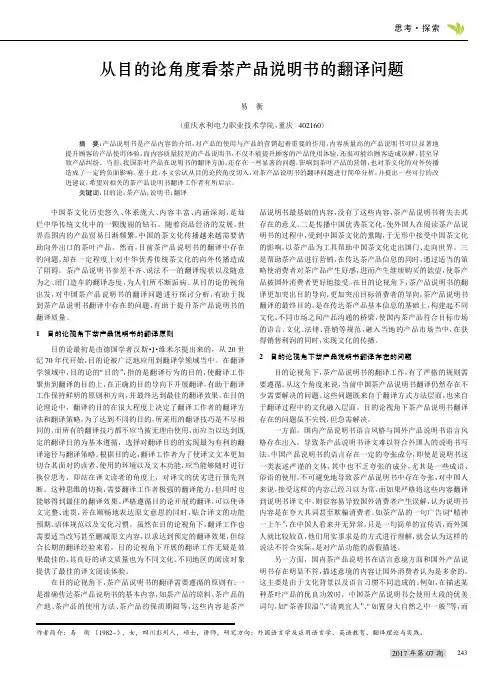
2017年第07期中国茶文化历史悠久、体系庞大、内容丰富、内涵深刻,是灿烂中华传统文化中的一颗瑰丽的钻石。
随着商品经济的发展,世界范围内的产品贸易日渐频繁,中国的茶文化传播越来越需要借助向外出口的茶叶产品。
然而,目前茶产品说明书的翻译中存在的问题,却在一定程度上对中华优秀传统茶文化的向外传播造成了阻碍。
茶产品说明书参差不齐、说法不一的翻译现状以及随意为之、闭门造车的翻译态度,为人们所不断诟病。
从目的论的视角出发,对中国茶产品说明书的翻译问题进行探讨分析,有助于找到茶产品说明书翻译中存在的问题,有助于提升茶产品说明书的翻译质量。
1目的论视角下茶产品说明书的翻译原则目的论最初是由德国学者汉斯·J ·维米尔提出来的,从20世纪70年代开始,目的论被广泛地应用到翻译学领域当中。
在翻译学领域中,目的论的“目的”,指的是翻译行为的目的,使翻译工作聚焦到翻译的目的上,在正确的目的导向下开展翻译,有助于翻译工作保持鲜明的原则和方向,并最终达到最佳的翻译效果。
在目的论理论中,翻译的目的在很大程度上决定了翻译工作者的翻译方法和翻译策略,为了达到不同的目的,所采用的翻译技巧是不尽相同的,而所有的翻译技巧都不应当被无理由使用,而应当以达到既定的翻译目的为基本遵循,选择对翻译目的的实现最为有利的翻译途径与翻译策略。
根据目的论,翻译工作者为了使译文文本更加切合其面对的读者、使用的环境以及文本功能,应当能够随时进行换位思考,即站在译文读者的角度上,对译文的优劣进行预先判断。
这种思维的切换,需要翻译工作者极强的翻译能力,但同时也能够得到最佳的翻译效果。
严格遵循目的论开展的翻译,可以使译文完整、连贯,并在顺畅地表达原文意思的同时,贴合译文的功能预期、语体规范以及文化习惯。
虽然在目的论视角下,翻译工作也需要适当改写甚至删减原文内容,以求达到预定的翻译效果,但综合长期的翻译经验来看,目的论视角下开展的翻译工作无疑是效果最佳的,其良好的译文质量也为不同文化、不同地区的阅读对象提供了最佳的译文阅读体验。

从目的论看中文药品说明书的英译作者:段城来源:《新一代》2019年第16期摘要:本文从目的论的角度研究了中文药品说明书的英译,通过对几份中英文药品说明书的分析,总结出一些中文药品说明书英译的实用方法。
关键词:药品说明书;目的论;英译作为出口药品必不可少的附件,说明书随着不同国家地区贸易和合作的扩大,中国药品出口量也在不断增加。
为确保外国人能遵循国药的使用说明,其翻译质量非常重要。
而目前药品说明书的英译存在许多问题,这不仅影响了产品的出口,也给人们的生活带来了威胁。
一、目的论目的论首先由德国语言学家弗米尔提出,它将翻译看作有目的或意图的活动,注重翻译的目标读者。
根据目的论,翻译的最高原则是目的原则,其次是连贯原则和忠诚原则。
二、中文药品说明书的英译(一)直译法由于中英文药品说明书存在高度对等,直译是中文药品说明书英译中最常用的方法。
该方法满足了目的论的忠诚原则,实现了药品说明书的原始目的。
如:(1)原文:本品是一种血管紧张素转换酶抑制剂。
(Yasida)译文: This drug is an angiotensin converting enzyme inhibitor.(二)转换法1.词汇层面词义转换。
中文药品说明书中有许多医学词汇,译成英文时,译者需选择具有特殊医学意义的常用词。
如,“身心功能的失调,紊乱,障碍”总翻译为“disorder”,其在英文中常用意思是“杂乱,混乱,凌乱”。
所以译者应习得许多具有特殊医学意义的英语单词。
词性转换。
汉语多使用动词或动词短语,而英语多使用名词、名词短语和名词结构。
为适应目标读者的习惯,一些汉语动词在一定条件下应转换成英语名词。
如:(2)原文:本品与其他抗结核药配伍,治疗各种类型肺结核。
(Streptomycin)译文: This drug is effective in the treatment of all forms of pulmonary tuberculosis in association with other antitubercular drugs.2.句法层面语态转换。
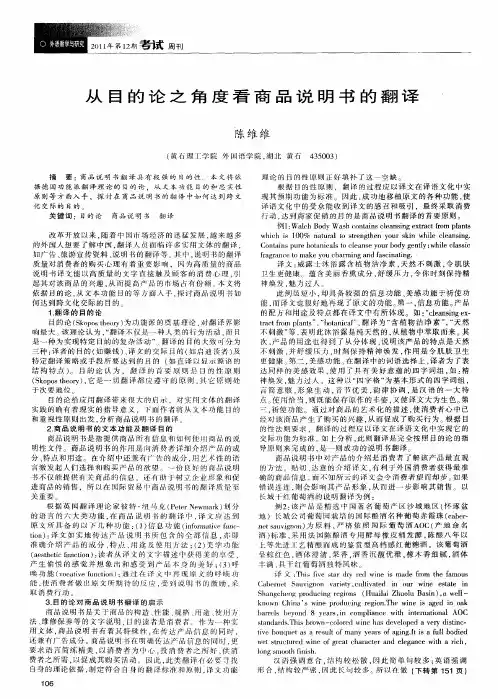
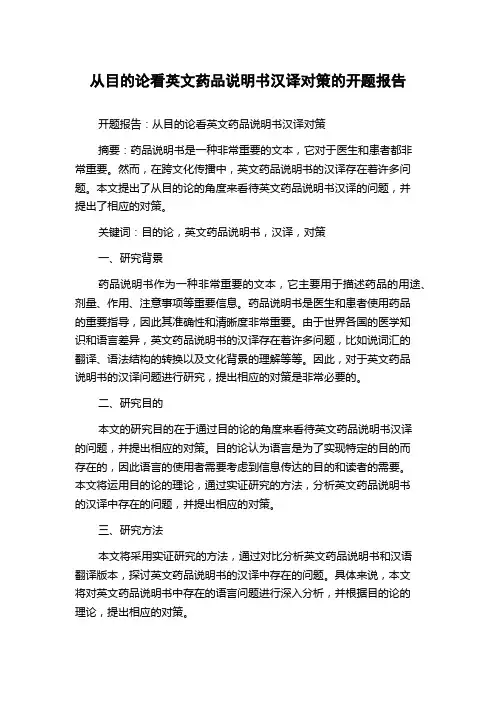
从目的论看英文药品说明书汉译对策的开题报告开题报告:从目的论看英文药品说明书汉译对策摘要:药品说明书是一种非常重要的文本,它对于医生和患者都非常重要。
然而,在跨文化传播中,英文药品说明书的汉译存在着许多问题。
本文提出了从目的论的角度来看待英文药品说明书汉译的问题,并提出了相应的对策。
关键词:目的论,英文药品说明书,汉译,对策一、研究背景药品说明书作为一种非常重要的文本,它主要用于描述药品的用途、剂量、作用、注意事项等重要信息。
药品说明书是医生和患者使用药品的重要指导,因此其准确性和清晰度非常重要。
由于世界各国的医学知识和语言差异,英文药品说明书的汉译存在着许多问题,比如说词汇的翻译、语法结构的转换以及文化背景的理解等等。
因此,对于英文药品说明书的汉译问题进行研究,提出相应的对策是非常必要的。
二、研究目的本文的研究目的在于通过目的论的角度来看待英文药品说明书汉译的问题,并提出相应的对策。
目的论认为语言是为了实现特定的目的而存在的,因此语言的使用者需要考虑到信息传达的目的和读者的需要。
本文将运用目的论的理论,通过实证研究的方法,分析英文药品说明书的汉译中存在的问题,并提出相应的对策。
三、研究方法本文将采用实证研究的方法,通过对比分析英文药品说明书和汉语翻译版本,探讨英文药品说明书的汉译中存在的问题。
具体来说,本文将对英文药品说明书中存在的语言问题进行深入分析,并根据目的论的理论,提出相应的对策。
四、预期成果本文预期将从目的论的角度分析英文药品说明书的汉译问题,并提出相应的对策。
研究结果将为药品说明书的汉译提供一些有效的指导,使得翻译者可以更加准确地将英文药品说明书转化为汉语版本。
同时,本文也将为翻译教育提供一些有益的思考。
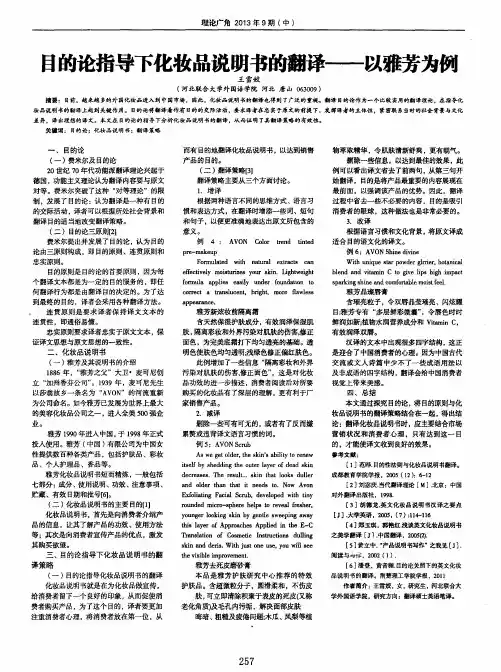
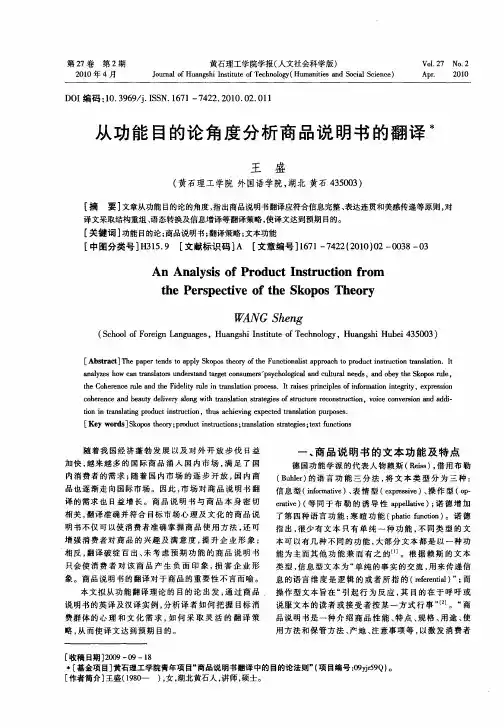
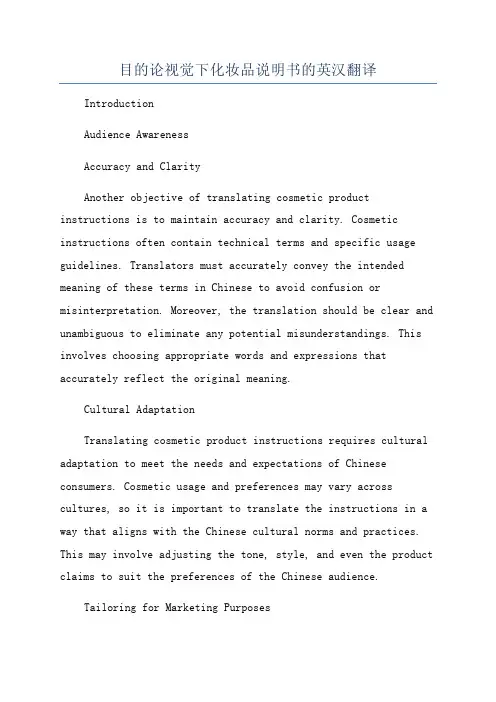
目的论视觉下化妆品说明书的英汉翻译IntroductionAudience AwarenessAccuracy and ClarityAnother objective of translating cosmetic product instructions is to maintain accuracy and clarity. Cosmetic instructions often contain technical terms and specific usage guidelines. Translators must accurately convey the intended meaning of these terms in Chinese to avoid confusion or misinterpretation. Moreover, the translation should be clear and unambiguous to eliminate any potential misunderstandings. This involves choosing appropriate words and expressions that accurately reflect the original meaning.Cultural AdaptationTranslating cosmetic product instructions requires cultural adaptation to meet the needs and expectations of Chinese consumers. Cosmetic usage and preferences may vary across cultures, so it is important to translate the instructions in a way that aligns with the Chinese cultural norms and practices. This may involve adjusting the tone, style, and even the product claims to suit the preferences of the Chinese audience.Tailoring for Marketing PurposesWhile the main focus of translating cosmetic product instructions is on accuracy and clarity, translators should also consider the marketing aspect. The translation shouldeffectively convey the brand image, values, and benefits to the Chinese audience. This involves adapting the instructions to align with the marketing strategy of the brand, emphasizing the unique selling points, and highlighting the benefits of the product. The translation should be persuasive and engaging to encourage potential customers to purchase and use the product.Conclusion。
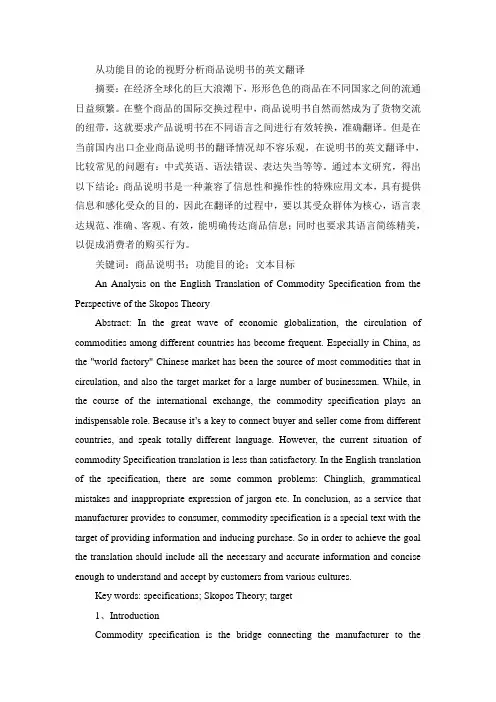
从功能目的论的视野分析商品说明书的英文翻译摘要:在经济全球化的巨大浪潮下,形形色色的商品在不同国家之间的流通日益频繁。
在整个商品的国际交换过程中,商品说明书自然而然成为了货物交流的纽带,这就要求产品说明书在不同语言之间进行有效转换,准确翻译。
但是在当前国内出口企业商品说明书的翻译情况却不容乐观,在说明书的英文翻译中,比较常见的问题有:中式英语、语法错误、表达失当等等。
通过本文研究,得出以下结论:商品说明书是一种兼容了信息性和操作性的特殊应用文本,具有提供信息和感化受众的目的,因此在翻译的过程中,要以其受众群体为核心,语言表达规范、准确、客观、有效,能明确传达商品信息;同时也要求其语言简练精美,以促成消费者的购买行为。
关键词:商品说明书;功能目的论;文本目标An Analysis on the English Translation of Commodity Specification from the Perspective of the Skopos TheoryAbstract: In the great wave of economic globalization, the circulation of commodities among different countries has become frequent. Especially in China, as the "world factory" Chinese market has been the source of most commodities that in circulation, and also the target market for a large number of businessmen. While, in the course of the international exchange, the commodity specification plays an indispensable role. Because it’s a key to connect buyer and seller come from different countries, and speak totally different language. However, the current situation of commodity Specification translation is less than satisfactory. In the English translation of the specification, there are some common problems: Chinglish, grammatical mistakes and inappropriate expression of jargon etc. In conclusion, as a service that manufacturer provides to consumer, commodity specification is a special text with the target of providing information and inducing purchase. So in order to achieve the goal the translation should include all the necessary and accurate information and concise enough to understand and accept by customers from various cultures.Key words: specifications; Skopos Theory; target1、IntroductionCommodity specification is the bridge connecting the manufacturer to theconsumer.It’s a pragmatic text that carries the informatio n and instruction of how to use the commodity. The function of commodity specification is to describe the components, features and usage of the product to consumer. Besides the introduction function it’s also a special advertisement with artistic language to attract and inspire customers to purchase the products. Thus a good commodity specification not only provides information about the goods, also demonstrates image and culture soft power of a company, at the same time promote the sale of goods, so the commodity specification in trade is so import. So in the great wave of economic globalization, the circulation of commodities among different countries has become frequent. Especially in China, more and more goods flow to the international market where customers come from various cultural backgrounds and speak totally different languages. In this case, the translation of commodity specification is crucial.1.1 The importance of transportation of commodity specificationIn the great wave of economic globalization, the circulation of commodities among different countries has become frequent. Especially in China, as the "world factory" Chinese market has been the source of most commodities that in circulation, and also the target market for a large number of businessmen. Thus more and more goods flow to the international market. However, in the course of the international exchange, the commodity specification plays an indispensable role. Because it’s a key to connect buyer and seller come from different countries, and speak totally different language. That means the transportation of product specifications between different languages must be accurate and effective. As a service that manufacturer provide to consumers, goods instruction is for the majority of consumer groups, so in order to cater to different tastes and different ages, its language must be targeted. A good translation not only allows consumers to understand, but also lead them to purchase. On the contrary, a flawed translation may show consumers a negative impression even damage the corporate image.1.2 The Current Situation of Export Enterprises’ Commodity Specification Translation at Home and abroad.At present, there is a large number of domestic export enterprises, but theproduct specification translation of them is not qualified enough, as with no professional standard. Generally, the more common problems are: Chinglish, grammatical errors, improper expression of jargon. There are many reasons for these problems, but the main reason is the lack of theoretical guidance. The mistakes can be concluded as: 1, from the perspective of translation content, translation of terminology is not standardized. 2. From the view of language, the language of translation context is too complex and not easy to understand, in other hands, the syntax is inflexible with the imperative sentence, passive sentences and simple sentences.Researches on specification translation are from a lot of fields, such as socio-semiotic view, aesthetics, cross-culture translation and Skopos Theory. Social Semiotics translation was proposed by the famous American structuralist, linguist and translator Eugene A.Nida, Nida believes: the world is composed of symbol, what’s most important is to understand the meaning of symbols, for to do so, we must understand the system where it exists firstly. So essentially, translation is transforming of different symbols (Sign, Sense & translation). Another perspective is aesthetic, Alexander Gottlieb Baumgarten (1714-1762) is the first person who proposed aesthetic. In his masterpiece Aesthetic published in 1750, he put forward the first definite claim for the funding of a new discipline-aesthetic, which is known as Aesthetics. In his view of Baumgarten,Aesthetic was originally a discipline for the study of human perception or feeling,which included human sense, affection, aspiration, imagination, fantasy, and intuition.2. The Text Function of Commodity SpecificationThe famous representative of functionalist school Reiss according based on Buhler’s theo ry divided the text into three types: informative, expressive, operative (same as appellative). Arnold adds the fourth features: phatic function. He pointed out that the text cannot be just simply a function but often include other different functions, sometimes one is the main, and other is complementary. According to Reiss, informative text is just the fact of communication which convey information in a logical dimension or referential; and operational text aims to "cause behavioralresponses, which aims to convince the reader to act by the recipient way. “Commodity specification is an application text, which can inspire consumers to buy and use the product by descripting the features, specifications, and usage and storage method of the goods”. As a specia l application of the text, product specifications is informative and induced, which decided that the main purpose of it is to provide information and induced the audience, thus the language of specification must be accurate, objective, valid enough to convey product information clearly, at the same time concise enough for reader to understand.2.1 The Features of Words and Expressions2.1.1 JargonFor using a mass of jargon, language of specification is different from the one in real life. However, professional terms cannot be too professional to be understood by the common readers who come from various consumer groups. so we have to do some explain for the obscure terms, especially in the electronic products manual, interpret is inevitable and necessary. But some people think too much technical terms in the product description, will make it harder for consumers to read, for consumers may not be able to understand the words too professional. While the fact is less jargon will not make it easy to understand but make ambiguity, let alone the accuracy and original meaning. As the word “package” for example, even though other words like “bag” and “pack” convey the same meaning, but they are totally different in vary context.2.1.2 Concise and ComprehensiveAnother feature of the specification language is widely using of compound words and abbreviations. Compound word is a new word or phrase by combining the original phrase or affixation. Such as: hi-technology, radiophotography. Acronym form is relatively simple and easy to remember, for example: RCD--residual current device, FM—frequency modulation, IU --international unit, UPS--uninterruptible power supply, IC--integrated circuit and so on. The use of compound words and acronyms not only makes the context easier for readers but also make the high-tech products expertise popularize, in other hand, it cuts the publicity cost of manufacturers. So widespread use of such words can make translation ofspecification.2.2 The Features of Syntax2.2.1 Simple sentencesSimple sentences make the Product specification easier for consumers to understand. Therefore, the translation of product manual should try to use simple sentences and avoid excessive use of long sentences; particularly those sentences contain various clauses. In general, we don’t use syntactical rhetorical devices in the products specification, but just the straight forward language. However, for some product specifications we have to use some artistic and beautiful rhetoric, in order to attract the attention of consumers, but the sentence is still simple. For example, on a clothing specification translation we should convey the information that this T-shirt is cheap, but the workmanship is excellent with unique design. Correspondingly translation is:This T-shirt is moderately priced, of excellent craftsmanship and unique in design. The English version of this sentence is just simple sentences. But with the words "moderately", "excellent" and "unique" convey all the information that can induce customers perfectly. Such adjectives or adverbs fully is competent to express the effect of complex sentences, aroused the desire of consumers, make the specifications also be a excellent advertisement.2.2.2 Imperative sentencesIn the commodity specification, if we want express the meaning of "Precautions" and “instructions” the imperative sentence is a better choice. Imperative sentence is one of simple sentence, which could express suggestions, orders and warnings tone. Therefore, in the commodity specification, imperative sentence can express advice and instructions better, as a sentence with no subject, the verb of it is generally prototype. There are two advantages of imperative sentence: only one verb tense, without complex temporal transformation, which makes it easy to understand, On the other hand, without the subject, it could explain how to use the product to customers bluntly, with the simple and clear expression.2.2.3 Passive SentencesEither Chinese or English, the most important grammar part is the predicate verb.In English grammar, there are two kinds of voice, the active voice and the passive voice. In most contexts, both the active and passive voice could express the same meaning, but the effect of two expression is totally different, the language and expression of passive sentences is more objective, and the object of action is more prominent. As the main purpose of the commodity specification is to explain how to use its products and precautions to consumers. So the third person viewpoint will make context more objective and authentic, not like the excessive use of the first person, second person, just leave a subjective sense to the reader.3. The Principle and Approach of Commodity Specification3.1 Skopos theory1970s, the German functionalist translation theorist Hans Vermeer (Hans Vermeer) proposed the Skopos theory of Translation. It broke the "equivalence theory" which was dominant in western. Vermeer thought: "it (Skopos Theory) is an integral part of the translatoriesches handeln, which concerns that translation is an act that based on source text, any form of translation has goals and objectives ", (Vermeer, 1986). In other words, any act of translation is determined by the purpose of the translation, which is said, "it was decided by the method (The end justifies the means)" (Nord, 2001: 29). Skopos theory was first proposed by the German scholar Vermeer (H.J.Vemmer) in 1978. Skopos in Greek means "purpose." In the view of Teleological theory the most important rule we should follow in translation is "The purpose of the law" (skopos) that means, the purpose of translation behavior determines the overall translation process. So, in translation of goods specifications, the most important determinant of translation purposes is audience, namely consumers who have their own cultural background, expectations and communication needs. Each translation aims to certain audience, so translation is a discourse with particular purpose and context.In conclusion, according to the Skopos theory, translation is a kind of cross-cultural transfer activity, while it is not just a conversion behavior, but of an entire complex behavior (Snell-Hornby.2006: 50). With the restricted purpose, the translator should considering the communicative expectations of the text and targetreaders, to choose appropriate translation strategies or methods.3.2 The Principle of Commodity Specification TranslationAccording to the theory mentioned above, it is obvious that translation of commodity specification should correspond to the principle of information integrity, coherence and aesthetic, we will analyze it with the case below:Original:本产品选用绿色优质大米为原料,采用国内最先进的现代化米排粉生产线,综合广东省内、外传统工艺精制而成,绝不含任何添加剂等化学物质,质量上乘,爽滑可口,烹饪方便,荤素随意,四季皆宜,蒸、煮、炒、火锅、凉拌、少许加辣更有一番风味。
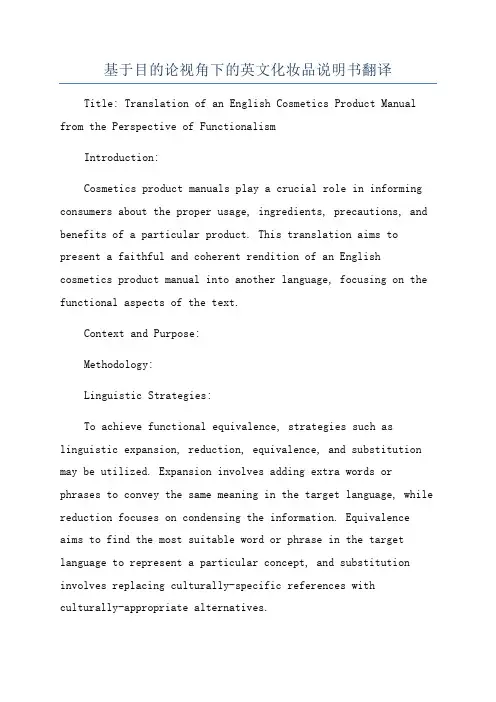
基于目的论视角下的英文化妆品说明书翻译Title: Translation of an English Cosmetics Product Manual from the Perspective of FunctionalismIntroduction:Cosmetics product manuals play a crucial role in informing consumers about the proper usage, ingredients, precautions, and benefits of a particular product. This translation aims to present a faithful and coherent rendition of an English cosmetics product manual into another language, focusing on the functional aspects of the text.Context and Purpose:Methodology:Linguistic Strategies:To achieve functional equivalence, strategies such as linguistic expansion, reduction, equivalence, and substitution may be utilized. Expansion involves adding extra words or phrases to convey the same meaning in the target language, while reduction focuses on condensing the information. Equivalence aims to find the most suitable word or phrase in the target language to represent a particular concept, and substitution involves replacing culturally-specific references withculturally-appropriate alternatives.Cultural Considerations:Conclusion:The translation of cosmetics product manuals requires the translator to consider the functional aspects of the text, catering to the needs and expectations of the target audience. By adopting a purpose-driven approach and employing linguistic and cultural strategies, it is possible to create a translation that accurately conveys the original information while being culturally appropriate and engaging for the readers.。
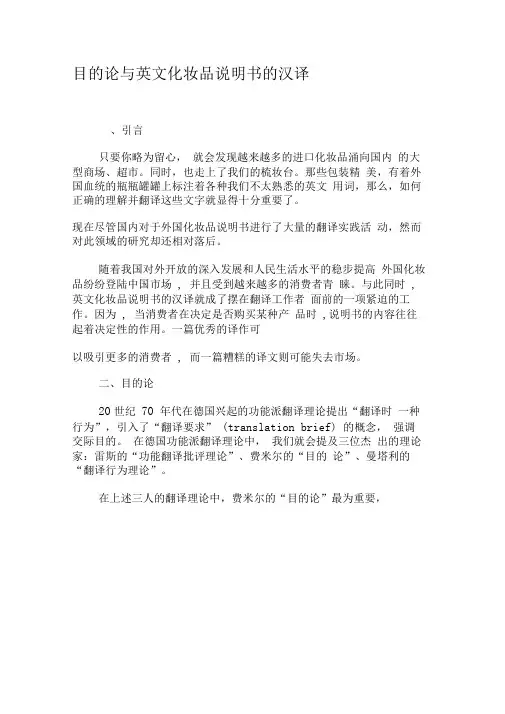
目的论与英文化妆品说明书的汉译、引言只要你略为留心,就会发现越来越多的进口化妆品涌向国内的大型商场、超市。
同时,也走上了我们的梳妆台。
那些包装精美,有着外国血统的瓶瓶罐罐上标注着各种我们不太熟悉的英文用词,那么,如何正确的理解并翻译这些文字就显得十分重要了。
现在尽管国内对于外国化妆品说明书进行了大量的翻译实践活动,然而对此领域的研究却还相对落后。
随着我国对外开放的深入发展和人民生活水平的稳步提高外国化妆品纷纷登陆中国市场, 并且受到越来越多的消费者青睐。
与此同时, 英文化妆品说明书的汉译就成了摆在翻译工作者面前的一项紧迫的工作。
因为, 当消费者在决定是否购买某种产品时,说明书的内容往往起着决定性的作用。
一篇优秀的译作可以吸引更多的消费者, 而一篇糟糕的译文则可能失去市场。
二、目的论20世纪70 年代在德国兴起的功能派翻译理论提出“翻译时一种行为”,引入了“翻译要求” (translation brief) 的概念,强调交际目的。
在德国功能派翻译理论中,我们就会提及三位杰出的理论家:雷斯的“功能翻译批评理论”、费米尔的“目的论”、曼塔利的“翻译行为理论”。
在上述三人的翻译理论中,费米尔的“目的论”最为重要,对外宣翻译有着特别重要的指导意义。
“目的论”中有一个重要 概念,即:“翻译要求”。
它包括译文的功能、译入语接受者、接受译文的时间、 地点、 译文传播的途径以及产生或接受译文的的论”中有三个重要的法则,即目的法则 (skopos rule) 、语际 连贯 (intertextual coherence) 、语内连贯 (intratextualcoherence) 。
语际连贯指的是译文与原文之间存在的某种关系, 这种关系也常被称为对原文的“忠实” (fidelity) 。
语内连贯指 的是译文在译入语文化及交际情景中应该有意义, 它强调译入语 文化及交际情景。
费米尔认为, 语际连贯或“忠实”应从属于语内连贯,同时,两者有都从属于“目的法则”。
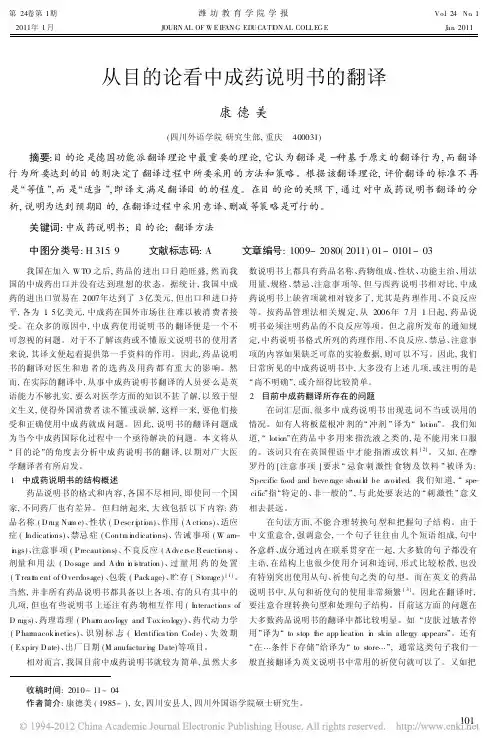
第24卷第1期潍坊教育学院学报Vo.l24No.1 2011年1月J OURNAL OF W E IF ANG ED UCATI ONAL COLLEGE J an.2011从目的论看中成药说明书的翻译康德美(四川外语学院研究生部,重庆400031)摘要:目的论是德国功能派翻译理论中最重要的理论,它认为翻译是一种基于原文的翻译行为,而翻译行为所要达到的目的则决定了翻译过程中所要采用的方法和策略。
根据该翻译理论,评价翻译的标准不再是/等值0,而是/适当0,即译文满足翻译目的的程度。
在目的论的关照下,通过对中成药说明书翻译的分析,说明为达到预期目的,在翻译过程中采用意译、删减等策略是可行的。
关键词:中成药说明书;目的论;翻译方法中图分类号:H315.9文献标志码:A文章编号:1009-2080(2011)01-0101-03我国在加入W TO之后,药品的进出口日趋旺盛,然而我国的中成药出口并没有达到理想的状态。
据统计,我国中成药的进出口贸易在2007年达到了3亿美元,但出口和进口持平,各为1.5亿美元,中成药在国外市场往往难以被消费者接受。
在众多的原因中,中成药使用说明书的翻译便是一个不可忽视的问题。
对于不了解该药或不懂原文说明书的使用者来说,其译文便起着提供第一手资料的作用。
因此,药品说明书的翻译对医生和患者的选药及用药都有重大的影响。
然而,在实际的翻译中,从事中成药说明书翻译的人员要么是英语能力不够扎实,要么对医学方面的知识不甚了解,以致于望文生义,使得外国消费者读不懂或误解,这样一来,要他们接受和正确使用中成药就成问题。
因此,说明书的翻译问题成为当今中成药国际化过程中一个亟待解决的问题。
本文将从/目的论0的角度去分析中成药说明书的翻译,以期对广大医学翻译者有所启发。
1中成药说明书的结构概述药品说明书的格式和内容,各国不尽相同,即使同一个国家,不同药厂也有差异。
但归纳起来,大致包括以下内容:药品名称(D rug N a m e)、性状(D escr i pti on)、作用(A ctions)、适应症(Indicati ons)、禁忌症(Contra i ndicati ons)、告诫事项(W arn-i ngs)、注意事项(P recauti ons)、不良反应(A dve rse R eacti ons)、剂量和用法(Do sage and A d m i n i stration)、过量用药的处置(T rea t m ent of O verdosage)、包装(Package)、贮存(Storage)[1]。
浅析目的论视角下的农产品包装说明翻译探究“翻译目的论”的基本思想对于汉译英起着指导作用。
本文将以“翻译目的论”为指导,分析汉译英的案例,以更好地阐释目的论在翻译实践中的重要作用。
标签:目的论;农产品说明书;翻译失误;翻译策略随着经济全球化的发展,农产品出口贸易日益繁荣,农产品包装翻译的好坏与农产品是否收欢迎也密切相关。
成功的包装说明翻译是农产品走向世界,开拓国际市场和树立国际品牌的重要因素之一。
一、翻译目的论“翻译目的论”是德国功能学派提出的重要理论之一。
其主导思想为“目的决定手段”这在一定程度上打破了奈达对等理论等值等效的局限性,倡导具体的翻译策略、手段、方法及操作取决于翻译的目的,主要包含莱斯提出的文本类型理论、弗米尔的目的论(目的法则、连贯法则、忠实法则)及诺德的“功能+忠诚”原则。
这一理论的提出对应用型文本的翻译起着举足轻重的作用。
莱斯将文本类型归为三类:信息型文本、表情型文本及操作型文本。
文本的类型取决于文本本身的功能,即文本功能决定文本类型,也决定翻译策略、方法及实操。
然而,翻译实践证明有些文本很难归类到哪一种具体的文本类型中,这些文本兼具两种文本类型或三种文本类型的特点。
由此可见,单纯的依据莱斯的文本类型理论进行翻译有其明显的不足之处。
而弗米尔目的论的提出弥补了莱斯理论不足之处。
弗米尔的“目的论”是翻译目的论的支柱理论,包含目的法则、连贯法则和忠实法则。
目的法则体现了任何文本都是为了某一目的而制作的,并为这一目的而服务的思想。
据诺德的那个目的的主要因素是以文本发送者为导向的“意图”和以目标接受者为导向的“功能”。
二者发生冲突时,应优先考虑译文所意指的目标受众,考虑他们的文化背景知识、对译文的理解及译文应达到的交际需求。
连贯法则指译文和目标语目标受众的语言文化及心理习惯应一致,译文应具有可读性和可接受性,应“本土化”。
忠实法则指“译文应该与对应原文之间存在某种联系”。
这种联系即指译文对原文最大限度的忠诚。
目的论视角下的药品说明书的英译汉策略药品说明书是向使用者传达关于药物特性、剂量、用途和风险等重要信息的重要文档。
在将药品说明书从英语翻译为中文时,必须遵循一定的翻译策略,以确保信息的准确传达和易于理解。
以下是目的论视角下的药品说明书的英译汉策略:1. 保持准确性:在翻译药品说明书时,准确性是最重要的要求之一。
译者应准确理解原文中的每个术语、表达和句子结构,并确保在翻译过程中保留核心信息。
专业词汇和医学术语的翻译应参考相应的药学资料和行业标准。
2. 简化语言:药品说明书的目标读者通常是普通患者,而非医学专业人士。
因此,译者应尽量简化语言,使用通俗易懂的词汇和句子结构,避免使用过于复杂的专业术语和繁琐的句子。
同时,应注意语言的连贯性,避免使用模糊或含糊的表达方式,以确保读者能够准确理解药物的使用方法和注意事项。
3. 注重目的和效果:药品说明书的目的是提供使用者必要的信息,并引导他们正确使用药物,并减少可能的风险。
在翻译过程中,译者应始终牢记这一目的,并通过选择合适的翻译策略和语言风格来实现这一目标。
例如,可以使用命令句或提示性语言来突出重要信息,以确保读者能够清楚地理解。
4. 确保一致性:为了避免产生混淆和误导,药品说明书的翻译应保持一致性。
译者应确保在整个说明书的翻译中使用相同的术语和表达方式,并注意使用一致的格式和风格。
此外,在翻译药品名称、剂量和用途等关键信息时,应与相关的药物注册文件保持一致。
综上所述,目的论视角下的药品说明书的英译汉策略包括保持准确性、简化语言、注重目的和效果以及确保一致性。
通过采用这些策略,译者可以有效传达药物的重要信息,并帮助读者正确使用药品,从而提高药物的使用效果和安全性。
基于目的论视角下的英文化妆品说明书翻译1. 介绍1.1 任务概述在国际贸易和跨文化交流日益频繁的今天,准确翻译英文化妆品说明书对于进一步拓展市场至关重要。
本文将从目的论的视角出发,探讨如何进行有效的英文化妆品说明书翻译,以满足消费者需求并确保准确传达产品信息。
1.2 目的论目的论是翻译学中的一种理论模型,强调翻译的目的和功能。
在英文化妆品说明书翻译中,目的论角度能够帮助翻译者更好地理解目标读者,并用他们能够理解和接受的语言准确传达信息。
2. 目标读者分析2.1 需求分析在进行英文化妆品说明书翻译前,首先需要对目标读者进行分析,了解他们的需求。
目标读者可能是外国消费者、批发商、零售商等。
他们可能对产品的功效、用法、成分以及安全性感兴趣。
2.2 语言和文化背景了解目标读者的语言和文化背景对翻译工作至关重要。
不同国家或地区有不同的语言习惯和文化背景,翻译时需注意使用符合目标读者习惯的语言表达,并避免使用可能引起误解或争议的词汇。
3. 有效翻译策略3.1 准确传达信息在翻译过程中,准确传达产品信息是首要任务。
翻译者应通过准确翻译产品名称、功效描述、使用方法等关键信息,确保读者对产品有清晰的理解。
3.2 使用恰当的词汇和术语英文化妆品说明书中经常涉及专业术语和化学成分,翻译时应确保使用恰当的词汇和术语,以保证准确传达产品信息,并避免产生歧义。
3.3 科学严谨的语言化妆品说明书需要严谨科学,翻译时需使用正式、准确的语言,确保描述产品的成分、功效和使用方法时具备科学性和合理性。
3.4 简洁明了的表达避免使用过于复杂和冗长的语句,应使用简单明了的表达方式。
翻译时要考虑到目标读者的阅读体验,用简洁的语言传达清晰的信息。
4. 翻译技巧4.1 文化转换在翻译过程中,翻译者需要进行文化转换,将源语言中的文化特色与目标语言进行适当调整。
例如,在中国的化妆品说明书中可能会强调产品中的中药成分,而在国外可能更注重产品的天然成分或科技创新。
基于目的论视角下的英文化妆品说明书翻译一、本文概述在全球化的大背景下,化妆品行业日益国际化,英语作为全球通用语言,在化妆品说明书翻译中扮演着重要角色。
本文旨在探讨目的论视角下的英文化妆品说明书翻译,分析翻译过程中的主要挑战和策略,以及目的论如何指导翻译实践。
本文首先将对目的论的基本概念进行阐述,然后结合英文化妆品说明书的特点,探讨翻译过程中的语言转换、文化传递和读者接受度等问题。
通过具体案例分析,本文将揭示目的论在英文化妆品说明书翻译中的实际应用,旨在为翻译实践提供有益的参考和指导。
二、目的论翻译理论概述目的论(Skopos Theory)是20世纪70年代由德国翻译理论家汉斯·弗米尔(Hans Vermeer)提出的翻译理论,后经其学生诺德(Nord)进一步完善。
该理论颠覆了传统等值翻译理论的主导地位,强调了翻译行为的目的性和结果导向性。
根据目的论,翻译是一种有目的的交际行为,其首要原则是“目的原则”(Skopos Rule),即翻译应能在译入语情境和文化中,按译入语接受者期待的方式发生作用。
目的论还提出了“连贯性原则”(Coherence Rule)和“忠实性原则”(Fidelity Rule),作为对目的原则的补充和制约。
在目的论视角下,英文化妆品说明书的翻译不仅仅是语言层面的转换,更是一种跨文化的交际活动。
翻译过程中,译者需要根据目标读者的需求和期待,选择适当的翻译策略和方法,以实现信息传递、文化交流和商业推广等多重目的。
因此,译者在进行英文化妆品说明书翻译时,应充分考虑目标市场的文化背景、消费习惯、审美偏好等因素,以确保译文能够准确、有效地传达原文的信息和功能。
目的论也强调译者的主体性和创造性。
译者作为翻译活动的主体,应充分发挥其主观能动性,根据翻译目的和语境需求,灵活运用各种翻译技巧和方法,以实现最佳的翻译效果。
在英文化妆品说明书翻译中,译者可以通过调整句式结构、增减信息、转换表达方式等手段,使译文更符合目标读者的阅读习惯和审美需求。
从目的论角度看化妆品类产品说明书英汉翻译中的词性转换论
文大纲
从目的论角度看化妆品类产品说明书英汉翻译中的词性转换
论点陈述:在化妆品类说明书英译汉过程中,一些必要的词性转换会使中国顾客更容易接受。
大纲
1.介绍
1.1背景和该研究的重要性
1.2研究问题和研究方法
1.3该论文的结构
2.化妆品类产品说明书中的词性转换
2.1词性转换定义
2.2类型
2.2.1转化为动词
2.2.1.1名词转换为汉语动词
2.2.1.2介词转换为汉语动词
2.2.1.3形容词转化为汉语动词
2.2.1.4副词转换为动词
2.2.2转化为名词
2.2.2.1动词转化为名词
2.2.2.2形容词转化为名词
2.2.2.3副词转化为名词
2.2.3转化为形容词
2.2.
3.1名词转化为形容词
2.2.
3.2副词转化为形容词
2.2.4转化为副词
2.2.4.1形容词转化为副词
3.从目的论角度分析化妆品产品说明中的词性转换3.1转化为动词的目的
3.2转化为名词的目的
3.3转化为形容词的目的
3.4转化为副词的目的
4.结论
5.文献综述。
英语专业全英原创毕业论文,公布的题目可以用于直接使用和参考(贡献者ID 有提示) 最新英语专业全英原创毕业论文,都是近期写作 1 进退维艰的女性—《儿子与情人》的女性主义分析 2 网络委婉语中的模因现象研究 3 从合作原则浅析《飞屋环游记》中的言语幽默 4 愤怒的尊严——浅析《愤怒的葡萄》中失土农民的抗争历程 5 《汤姆·索亚历险记》中所反映的社会问题 6 从功能对等理论角度看校训的汉英翻译原则 7 从功能翻译理论看电影《功夫熊猫》的字幕翻译 8 《雾都孤儿》中的批判现实主义 9 A Study of Narrative Voice in Jodi Picoult’s My Sister’s Keeper 10 An Analysis of the Development and Future of Gothic Novel 11 商务英语翻译中的委婉表达 12 反殖民主义战士还是殖民拥护者——对黑暗之心的解读 13 论中美两国的现代中年女性观念之差——以美剧《欲望都市》为例 14 网络环境下英语自主学习模式的调查 15 美国英语新词汇特点 16 用功能对等原则分析广告标语的英汉互译 17 广告语中预设触发语的语用分析 18 《威尼斯商人》中宗教和法律的冲突 19 论《红楼梦》在英语世界的传播与误读 20 英汉动物谚语中动物形象的意义及翻译 21 《白鲸》的象征意义和悲剧内涵分析 22 浅析《喜福会》中母亲们悲惨遭遇的成因 23 解读《拉帕希尼的女儿》中的父爱 24 文化适应性原则在食品商标翻译中的应用 25 《鲁滨逊漂流记》中鲁滨逊的资产阶级特征 26 论“看,易,写”方法在旅游翻译中的应用 27 “黑人会飞”——托妮•莫里森小说《所罗门之歌》中的黑人神话研究 28 论《献给爱米莉的玫瑰》的艺术创作特征 29 关于形成性评价在初中英语教学中应用的调查报告 30 论《紫色》的社会意义 31 商标的特征及其翻译的分析 32 家庭教育对保罗的影响:品读《儿子与情人》 33 初中英语词汇教学法研究综述 34 报刊杂志词频分析与大学英语教学中词频分析的比较 35 浅析《红字》中女性主义的具体体现 36 从《芒果街上的小屋》透视女性自我意识的觉醒 37 英汉颜色词的认知语义分析—以红色、黄色为例 38 A Popular Form of Subtitles Translation by Fansub Group on the Internet 39 浅谈《圣经》对英语习语的影响 40 从文化视角看中西方的礼节差异 41 澳大利亚英语词汇和澳大利亚文化(开题报告+论) 42 对于高中生英语学习感知风格的调查研究 英语专业全英原创毕业论文,公布的题目可以用于直接使用和参考(贡献者ID 有提示) 43 The Elementary Stage Translation Teaching Design for Undergraduate English Majors 44 归化与异化策略在字幕翻译中的运用 45 从跨文化角度看习语翻译 46 英汉习语文化差异浅析 47 论《奥兰多》中双性同体观 48 解析《诺桑觉寺》中凯瑟琳的自我成长 49 浅析英语新闻标题的语言特征 50 论风格的可译性 51 《瓦尔登湖》与陶渊明作品中的自然观简析 52 从目的论角度分析英语电影片名的翻译( ) 53 对《老人与海》中主人公的性格分析 54 从文化价值观对比研究中美企业管理模式的差异 55 “庸人”自扰——《普鲁弗洛克情歌》主题探究 56 Study on the Mute and Deaf People’s Language 57 法律术语的模糊性及其翻译 58 对黑人妇女在民权运动期间争取教育权的背景分析 59 浅谈进口商品商标的翻译 60 The Inconsistencies between Margaret Mitchell’s Gone with the Wind and Alexandra Ripley’s Scarlett 61 理智的动人诗篇——《马语者》 62 中国和英国传统婚俗差异研究 63 目的论指导下的化妆品品牌翻译 64 分析《简爱》和《名利场》中的女性主义 65 《夏日鸟笼》的女性主义解读 66 Translation Strategies of Two-part Allegorical Sayings 67 《推销员之死》中的家庭问题研究 68 接受美学指导下的电影字幕翻译——以《冰河世纪II》为例 69 从跨文化角度对品牌名称的研究——以化妆品品牌为例 70 美国黑人英语在电影中的应用研究 71 《荆棘鸟》女性意识浅析 72 论《呼啸山庄》中两代人之间不同的爱情观 73 Purity and Doom: on Thomas Hardy’s Tess’s of the d’Urbervilles 74 《宠儿》中塞丝的性格特征分析 75 浅析《飘》中的女性意识 76 On the Cultural Signification and Translation of Animal Idioms 77 美国梦的迷失—解析《了不起的盖茨比》 78 如何增强小学生英语课堂教学的趣味性 79 从玛氏公司看英美文化对广告的影响 80 《追风筝的人》中阿米尔的性格分析 81 Research on the Re-creation in the Translation of the Trademarks in Different Cultures 82 目的论视角下的《边城》的英译研究 83 论证北美独立战争的合法性—重读托马斯.潘恩的《常识》 84 浅析《飘》中女主人公的性格特征 85 从文化角度论英文商标名称的翻译 英语专业全英原创毕业论文,公布的题目可以用于直接使用和参考(贡献者ID 有提示) 86 从心理语言学的角度探讨消极情绪的语言表达 87 英国海洋文化对英语习语的影响 88 女性意识在《红字》中的表现 89 中美大学毕业典礼演讲之叙事结构的比较研究 90 汉英谚语中关于文化价值观的比较 91 从功能翻译理论看电影《功夫熊猫》的字幕翻译 92 英语课堂教学—教师主宰还是学生为中心 93 《野性的呼唤》中的自然主义 94 《咏水仙》两个翻译版本的文体分析 95 从社会生物学角度分析《雾都孤儿》中人物性格 96 从儿童心理角度看儿童文学中的对话翻译 97 公示语翻译的问题及对策研究 98 仿拟在商业广告中的应用 99 探析《霍乱时期的爱情》的悲剧美 100 Eco-Critical Reading of The Call of the Wild 101 初中英语教学中的角色扮演 102 英语单词记忆中存在的主要问题和解决方法 103 分析《土生子》中的种族主义的恶性影响 104 从“水”的隐喻看中西文化的差异 105 浅析《儿子与情人》中的象征意蕴 106 C-E Translation of Public Signs—From the Perspective of Functionalism 107 A Brief Study of Chinglish in C-E Translation 108 从中美管理方式的不同透析中西方文化差异与整合 109 从生态女性主义视角解读《永别了,武器》 110 从中美文化差异看中国人创新能力的缺失与培养 111 英汉语篇中的省略衔接手段对比及其翻译方法——以《雪》译文为例 112 论《傲慢与偏见》中的女性意识 113 爱伦坡短篇小说的艺术特色 114 An Analysis of Female Images in The Thorn Birds 115 论肢体语言在中国英语课堂教学中的合理应用 116 《贵妇的画像》的过渡性特征的分析研究 117 The Archetype of the Ugly Duckling in The Secret Garden 118 浅析《蝇王》的人物及其象征意义 119 Advertising Language: A Mirror of American Value 120 The Heroism in The Old Man and the Sea 121 英汉被动句语义特征对比分析 122 中国和英国传统婚俗差异研究 123 论国际商务非礼貌言语行为 124 哥特文化--十字架背后的光 125 A Summary of Symbols of The Scarlet Letter 126 On the Translation of Tourism Advertisements 127 中西方餐桌礼仪差异之比较 128 从中美文化差异看中国人创新能力的缺失与培养 129 Metaphorical Analysis of Polysemy and Its Application in English Teaching 英语专业全英原创毕业论文,公布的题目可以用于直接使用和参考(贡献者ID 有提示) 130 出人意料的结局和夸张-基于欧亨利的短篇小说《忙碌经纪人的罗曼史》 131 从春节与圣诞节习俗看中西方文化差异 132 英语委婉语的语用分析 133 On Beautiful Women’s Death in Poe’s Fictions 134 协商课程在高中英语教学中的应用初探 135 从语言功能考察汉语公示语英译 136 小说《白鲸》中亚哈布船长的人物悲剧解读 137 A Contrastive Study of English and Chinese Gratitude Expressions 138 从《远大前程》看狄更斯的家庭理想 139 英语影视的课堂价值 140 艾丽丝•沃克《日用家当》中的人物解读 141 教师身势语在英语口语教学中的应用 142 Who Is Ishmael: Kantian Philosophy in Moby Dick 143 论促销在市场经济中的重要性 144 从《徳伯家的苔丝》看哈代的贞操观和道德观 145 浅谈《红楼梦》诗词的文化意象翻译 146 英语新闻标题的汉译方法——以英国《金融时报》中文网为例 147 浅析《汤姆叔叔的小屋》写作技巧 148 改写理论视角下看葛浩文《狼图腾》的英译 149 Jane Austen’s Opinion towards Marriage in Pride and Prejudice 150 试谈母语对外语学习的影响 151 An Analysis of Gender in Oh,Pioneers! 152 《汤姆叔叔的小屋》中的圣经人物原型分析 153 《小妇人》中乔的形象分析 154 隐转喻名名复合词的语义分析 155 英汉禁忌语对比在跨文化交际中的应用及翻译策略 156 构建和谐社会——以美籍黑人的种族歧视为例 157 论英汉口译中的数字互译 158 《名利场》中的女主人公性格分析 159 On Translation Strategies of Animal Idioms between English and Chinese 160 A Comparative Study of Refusal in Chinese and American Cultures 161 中西方时间观差异分析 162 解读奥斯丁小说《诺桑觉寺》对哥特传统的模仿与颠覆 163 古诗英译中意象与意境的处理 164 论基督教教义对美国人慈善观的影响 165 《了不起的盖茨比》中色彩的象征意义(开题报告+论) 166 从语义翻译与交际翻译看《红楼梦》中诗词的汉译英 167 “去十九号房”中的自由观 168 探讨星巴克多样化顾客关怀及其推广性 169 高中英语写作作业的反馈及实施效果 170 从合作原则分析《生活大爆炸》中字幕幽默的翻译 171 浅析《小妇人》中乔的女性意识及其成长过程 172 Man-and-Nature Relationship in Moby-Dick 173 从文学作品中透析东西方女性异化现象